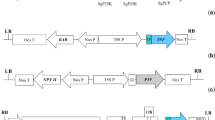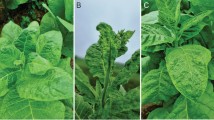Abstract
The genus Tobravirus comprises three species: Tobacco rattle virus, Pea early-browning virus and Pepper ringspot virus. The genomes of tobraviruses consist of two positive-sense single-stranded RNA segments (RNA1 and RNA2). Infectious clones of TRV are extensively used as virus-induced gene-silencing (VIGS) vectors for studies of virus-host interactions and functions of plant genes. Complete infectious clones of pepper ringspot virus (PepRSV), the only tobravirus present in Brazil, however, have not yet been reported. Infectious clones will help to identify unique features of PepRSV RNA2 and provide another option for development of VIGS vectors. We constructed infectious clones based on two PepRSV isolates, CAM (RNA1 and RNA2) and LAV (RNA2). The cDNA constructs for both homologous (RNA1 and RNA2 of the CAM isolate) and heterologous (RNA1/CAM and RNA2/LAV) combinations were infectious in Nicotiana benthamiana plants. VIGS vector constructs with green fluorescent protein or phytoene desaturase genes inserted in RNA2 silenced the target genes. The systemic translocation of the PepRSV RNA1 construct alone (nonmultiple infection) was also confirmed in an N. benthamiana plant. These results are similar to those reported for tobacco rattle virus.





Similar content being viewed by others
References
MacFarlane SA (1999) Molecular biology of the tobraviruses. J Gener Virol 80:2799–2807. https://doi.org/10.1099/0022-1317-80-11-2799
MacFarlane SA (2010) Tobraviruses—plant pathogens and tools for biotechnology. Mol Plant Pathol 11:577–583. https://doi.org/10.1111/j.1364-3703.2010.00617.x
Batista ARS, Nicolini C, Rodrigues KB et al (2014) Unique RNA 2 sequences of two Brazilian isolates of Pepper ringspot virus, a tobravirus. Virus Genes 49:169–173. https://doi.org/10.1007/s11262-014-1066-8
Bergh ST, Koziel MG, Huang SC et al (1985) The nucleotide sequence of tobacco rattle virus RNA- 2 (CAM strain). Nuc Acids Res 13:8507–8518
Ratcliff F, Martin-Hernandez AM, Baulcombe DC (2001) Tobacco rattle virus as a vector for analysis of gene function by silencing. Plant J 25:237–245. https://doi.org/10.1046/j.0960-7412.2000.00942.x
MacFarlane SA, Popovich AH (2000) Efficient expression of foreign proteins in roots from tobravirus vectors. Virology 267:29–35
Blawid R, Nagata T (2015) Construction of an infectious clone of a plant RNA virus in a binary vector using one-step Gibson Assembly. J Virol Methods. https://doi.org/10.1016/j.jviromet.2015.05.003
Bucher E, Sijen T, Haan P et al (2003) Negative-strand tospoviruses and tenuiviruses carry a gene for a suppressor of gene silencing at analogous genomic positions. J Virol 77:1329–1336
Liu D, Shi L, Han C et al (2012) Validation of reference genes for gene expression studies in virus-infected Nicotiana benthamiana using quantitative real-time PCR. PLoS One 7(9):e46451
Liu E, Page JE (2008) Optimized cDNA libraries for virus-induced gene silencing (VIGS) using tobacco rattle virus. Plant Methods 4:1–5. https://doi.org/10.1186/1746-4811-4-5
Angenent GC, Posthumus E, Bol JF (1989) Biological activity of transcripts synthesized in vitro from full-length and mutated DNA copies of tobacco rattle virus RNA 2. Virology 173:68–76
Mueller AM, Mooney AL, MacFarlane SA (1997) Replication of in vitro tobravirus recombinants shows that the specificity of template recognition is determined by 5’ non-coding but not 3’ non-coding sequences. J Gen Virol 78:2085–2088. https://doi.org/10.1099/0022-1317-78-8-2085
Domingo E, Sheldon J, Perales C (2012) Viral quasispecies evolution. Microbiol Mol Biol Rev 76:159–216
Hamilton WDO, Baulcombe DC (1989) Infectious RNA produced by in vitro transcription of a full-length tobacco rattle virus RNA-1 cDNA. J Gen Virol 70:963–968
Sudarshana MR, Berger PH (1998) Nucleotide sequence of both genomic RNAs of a North American tobacco rattle virus isolate. Arch Virol 143:1535–1544. https://doi.org/10.1007/s007050050396
Liu Y, Schiff M, Marathe R et al (2002) Tobacco Rar1, EDS1 and NPR1/NIM1 like genes are required for N-mediated resistance to tobacco mosaic virus. Plant J 30:415–429. https://doi.org/10.1046/j.1365-313X.2002.01297.x
Burch-Smith TM, Anderson JC, Martin GB (2004) Applications and advantages of virus-induced gene silencing for gene function studies in plants. Plant J 39:734–746. https://doi.org/10.1111/j.1365-313X.2004.02158.x
Burch-Smith TM, Schiff M, Liu Y et al (2006) Efficient virus-induced gene silencing in Arabidopsis. Plant Phys 142:21–27. https://doi.org/10.1104/pp.106.084624
Acknowledgments
This work was supported by CNPq (project number 306377/2014-4). AKIN and TN are CNPq fellows.
Author information
Authors and Affiliations
Corresponding author
Ethics declarations
Conflict of interest
The authors declare that they have no conflicts of interest.
Ethical approval
This article does not contain any studies with human participants or animals performed by any of the authors.
Additional information
Handling Editor: Massimo Turina.
Publisher's Note
Springer Nature remains neutral with regard to jurisdictional claims in published maps and institutional affiliations.
Electronic supplementary material
Below is the link to the electronic supplementary material.
Supplementary Fig. 1.
The symptoms in Physalis pubescens (a) and Datura stramonium (b), when inoculated with the progeny of the infectious clones
Rights and permissions
About this article
Cite this article
Tavares-Esashika, M.L., Campos, R.N.S., Blawid, R. et al. Characterization of an infectious clone of pepper ringspot virus and its use as a viral vector. Arch Virol 165, 367–375 (2020). https://doi.org/10.1007/s00705-019-04505-5
Received:
Accepted:
Published:
Issue Date:
DOI: https://doi.org/10.1007/s00705-019-04505-5




